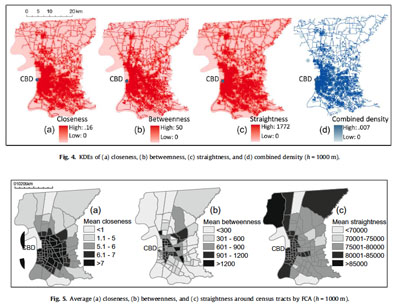 Ref: Wang F, Antipova A, Porta S, 2010, Street centrality and land use intensity in Baton Rouge, Louisiana, Journal of Transport Geography, In press.
Ref: Wang F, Antipova A, Porta S, 2010, Street centrality and land use intensity in Baton Rouge, Louisiana, Journal of Transport Geography, In press.
*** ***
This paper examines the relationship between street centrality and land use intensity in Baton Rouge, Louisiana. Street centrality is calibrated in terms of a node’s closeness, betweenness and straightness on the road network. Land use intensity is measured by population (residential) and employment (business) densities in census tracts, respectively and combined. Two GIS-based methods are used to transform data sets of centrality (at network nodes) and densities (in census tracts) to one unit for correlation analysis. The kernel density estimation (KDE) converts both measures to raster pixels, and the floating catchment area (FCA) method computes average centrality values around census tracts. Results indicate that population and employment densities are highly correlated with street centrality values. Among the three centrality indices, closeness exhibits the highest correlation with land use densities, straightness the next and betweenness the last. This confirms that street centrality captures location advantage in a city and plays a crucial role in shaping the intraurban variation of land use intensity.


